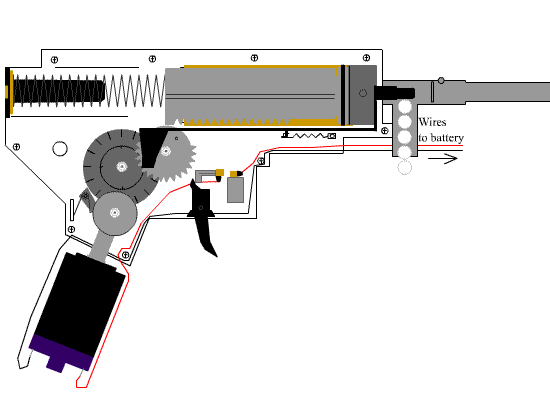History
Types of airsoft guns
Spring powered
Spring-powered airsoft guns are single-shot devices that use elastic potential energy(EPE) stored in a spring to compress air to launch an airsoft pellet down the barrel of the gun. The user must cock a spring gun prior to each shot. This is typically achieved by pulling back the slide (pistols), bolt (rifles), or the grip on a shotgun, which in turn compresses the spring and makes the gun ready to fire. Because of this, these guns are by definition incapable of automatic or semi-automatic fire. Spring powered airsoft guns are generally not as powerful as gas and electric models, although some spring shotguns and sniper rifles can be very powerful and shoot at velocities of over 500 FPS. These are hard to find and expensive, and don't usually last long because of the tension created by a powerful spring.
While most electric guns also use springs for propulsion of the airsoft pellet, they are not considered to be in the same category as the single-shot spring-powered guns. Low-end spring guns tend to be much cheaper than their electric-powered equivalents due to their simplicity and lack of electrical components (spring assembly, electric motor, battery, and battery charger) and thus are widely available. These guns are less suited for competition because they are at a disadvantage against automatic guns in close combat and do not provide enough accuracy and power for long-range use. There are some exceptions, however, as higher-end spring-powered airsoft rifles can be quite expensive; these guns are typically suited for "marksman" applications in airsoft matches and provide competitive muzzle velocities. Additionally, pump shotguns are sometimes used, especially in CQB (Close Quarters Battle). In colder weather, spring pistols are more reliable than gas-powered pistols and even the batteries on AEPs (Automatic Electric Pistols) both of which can be adversely affected by extreme cold. Although, in extreme weather, some players buy custom cold protection for their AEGs, but, this is very rare.
This represents one of the major advantages of spring powered airsoft gun, as it can be fired in any situation, without reliance on an external source of power, such as batteries or gas. The lack of reliance on external power sources causes some players to favor spring powered guns. Spring guns are also less susceptible to the effects of water, where a battery-powered gun could malfunction when wet.
Spring powered weapons are often cheaper than electric or gas powered weapons. They are also more readily available in most department stores. Because of their price and availability, spring guns tend to act as "training guns" to bring new players to airsoft games and are considered the primary weapon of "backyard skirmishes." Almost all airsoft players at some point owned a spring weapon, whether for its actual use in the sport or for the replica value since some airsoft weapons are only available as spring versions.
Automatic electric guns
These type of guns were developed in Japan and the Japanese company Tokyo Marui dominates the market. In a Tokyo Marui AEG, the motor drives a series of 3 gears mounted inside a gearbox. The gears then compress a piston assembly against a spring. Once the piston is released, the spring drives it forward through the cylinder to push a pellet into the chamber, through the barrel, and forward from the muzzle. Many manufacturers have now more or less replicated this basic model, adding reinforced parts or minor improvements. These guns are powered primarily by nickel cadmium (NiCd) or nickel metal hydride (NiMH) with varying voltages and milliampere hours ratings. The most common battery is an 8.4 V large battery (usually about 2400 mA•h.) Also available are 8.4 V "mini" batteries, which generally have 900-1700 mA•h capacities. Voltages for large batteries range from 7.2 V, all the way up to 12 V. The rule of thumb usually is the higher the mAh, the longer the battery lasts while the higher voltage, the higher Rate of Fire (RoF). Now, however, Lithium-Polymer, or Li-po, batteries are just coming into the airsoft world. These batteries can last longer and have higher mAh and Volts while at the same time, being small and light. Li-po batteries are usually at 11.1 V and at varying mAh from 500 mAh to 2400 mAh.
External modifications, such as metal bodies and reinforced plastics that make AEGs look and feel even more realistic, have become very popular. AEG manufacturers such as Classic Army and Tokyo Marui produce replicas that are visually nearly identical to their real counterparts. Tokyo Marui, however, sticks with a durable ABS plastic, whereas Classic Army features full metal bodied guns and stronger furnishings. Most AEGs produced as of late are designed to be as visually realistic as possible.
The two most common AEGs fielded by players are the AR-15 series (M16 rifle, M4 carbine, etc.; sometimes referred to as the Armalite or Colt series) and the Heckler & Koch MP5 series, because parts for repairs or modifications/customization are commonly available. Also popular are the AK or Kalashnikov, the Heckler & Koch G36 and more recently, the Springfield M14.


When it comes to airsoft guns you will find that you have three types to choose from. One uses gas, another uses electrical power to provide the energy and the third is fitted with a spring. As they all come with a wide variety of different extras and features it can prove somewhat difficult deciding what kind to buy, especially if you have never purchased such a gun before.
ReplyDeleteairsoft guns